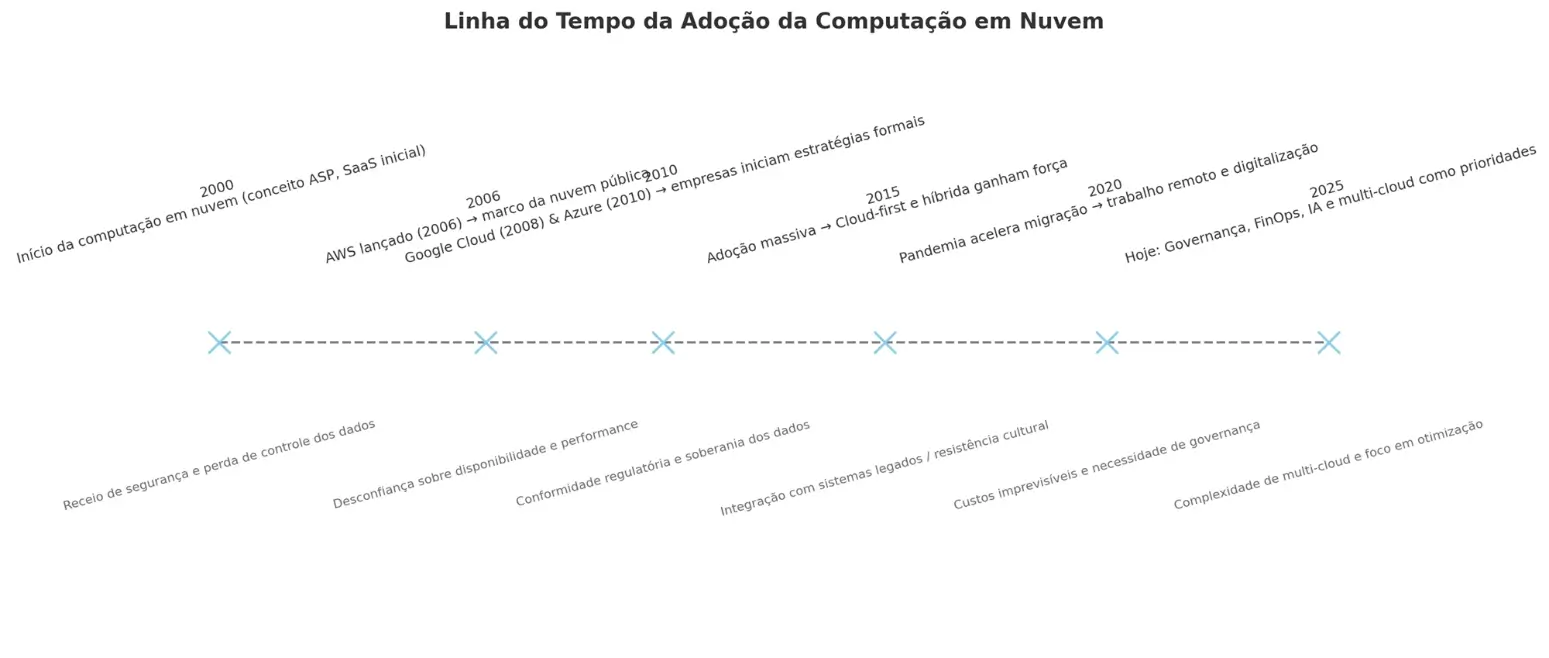In the early 2000s, cloud computing began to take shape, with platforms and services that changed the way organizations use infrastructure and applications. Important milestones include Amazon Web Services (AWS - with services such as EC2, launched in 2006), Google Cloud (2008), and Microsoft Azure (2010). Large-scale adoption accelerated starting in 2015, when many companies overcame initial fears and began to seek solid Cloud Governance models. Among the main challenges that slowed this adoption were:
- The fear of storing critical information outside their servers; for example, personal data, financial records, and business secrets that require protection and strict access policies.
- Availability and reliability; questions about SLA, continuity, and fault tolerance until governance practices and resilient architectures were adopted.
- The unpredictability of costs; charge-per-use models, idle resources, and inadequate provisioning generated surprises in the bill, stressing the need for cost control and optimization practices.
- The lack of capacity of IT teams to manage the new model; many teams needed training in new practices, cloud management tools, and models of shared responsibility between vendor and customer.
- The applications were not ready to run in the cloud; many legacy solutions required reengineering or migration by refactoring to take advantage of native resources and ensure adequate performance.
- Among others. These points reflect why the definition of cloud policies, controls, and governance practices has become a priority for companies seeking security, compliance, and resource optimization.

In the middle of 2025, many organizations have already enjoyed clear benefits of cloud computing, but several operational and strategic challenges persist. Below, we highlight the main points that require governance attention to ensure security, compliance, and resource optimization in cloud environments:
Invisible Costs
Idle resources, unnecessarily retained snapshots, and instances provisioned 24/7 are examples of waste that increase the bill without generating value. The lack of control policies and optimization practices prevents companies from monitoring and optimizing cloud services and resources, resulting in unpredictable costs.
Security Incidents
Configuration flaws, excessive permissions, and lack of access controls can expose sensitive data and compromise data protection. In addition to the operational impact, incidents may result in fines for non-compliance with regulations (for example, LGPD) and reputational damage. Governance must include access control policies, ongoing monitoring, and threat response.
Low Performance
Unoptimized architectures, lack of automatic scalability, and absence of improvement plans can reduce productivity and innovation capacity. Implementing governance practices, defining service levels (SLA), and appropriate use of cloud resources improves the performance of systems and applications.
These challenges highlight the importance of clear policies, controls, and governance practices (cloud governance) that align business objectives, regulatory compliance, and security, ensuring that the cloud is a transformation factor and not a source of unnecessary risks or costs.
Thinking about these challenges, the TATICCA team is prepared to support your organization in implementing good cloud governance practices, aligning business objectives, regulatory compliance, and safety. Our work focuses on transforming the cloud into a strategic asset, with a practical and results-oriented approach, applicable to platforms such as AWS, Google Cloud and Microsoft Azure.
Cost reduction with resource optimization.
We identify idle cloud resources, correct improper provisioning, and implement cost governance policies to control spending, reduce waste, and make service consumption more predictable.
Compliance with regulatory standards.
We evaluate compliance requirements (including LGPD and other industry standards), define data retention controls and policies, and create processes that ensure auditing, traceability, and compliance with regulations.
Strengthening security and business continuity.
We implement security controls, identity and access management (IAM), threat monitoring, and continuity and recovery plans, ensuring data protection and availability of critical systems.
Increased operational efficiency for your team to innovate with confidence.
Through governance, operation practices, and automation, we deliver controls that allow teams to focus on innovation, with clarity about responsibilities, policies, and service levels.
How we act (practical approach):
- Evaluate: diagnosis of the environment, inventory of resources, and identification of risks, costs, and compliance gaps;
- Plan: definition of policies, access controls, compliance journeys, and implementation roadmap;
- Operationalize: implementing automations, monitoring, resource optimization, and knowledge transfers to the internal team.
TATICCA combines cloud governance expertise with security and compliance practices to support companies in the efficient management of cloud services and infrastructure. We work with various platforms (including Google Cloud, AWS and Azure) and adapt the implementation to your environment and business objectives.
Do you want to understand how cloud governance can generate savings, improve security, and ensure regulatory compliance for your company?
Talk to the experts at TATICCA Allinial Global and discover how to transform your cloud structure into a strategic asset. Our governance, security, and compliance specialists assess your environment, identify resource optimization opportunities, and design policies and controls to protect data and systems, aligned with the organization's objectives.





